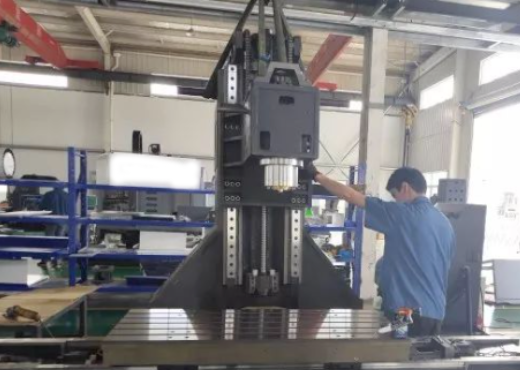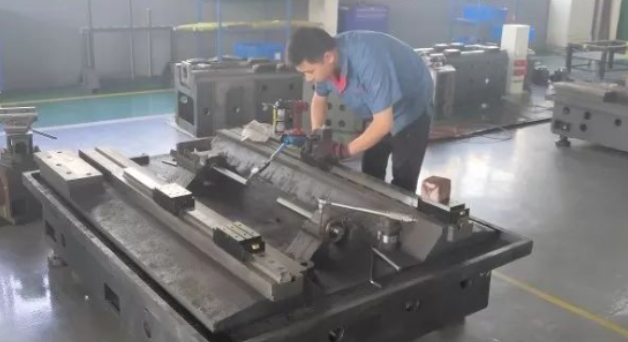CNC Machine manufacturers are doing their best to ensure the accuracy of guide rail installation. Before the guide rails are processed, the guide rails and working parts have been aged to eliminate internal stress. In order to ensure the accuracy of the guide rails and extend their service life, scraping is a common process method.
The new guide rail system enables machine tools to obtain fast feed speeds. Under the condition of the same spindle speed, fast feed is a feature of linear guide rails. Like plane guide rails, linear guide rails have two basic components; one is a fixed component as a guide, and the other is a moving component. In order to ensure the accuracy of the machine tool, a small amount of scraping on the bed or column is essential. Generally, the installation is relatively simple. The moving element and the fixed element of the linear guide rail do not use an intermediate medium, but rolling steel balls. Because rolling steel balls are suitable for high-speed movement, low friction coefficient, and high sensitivity, they meet the working requirements of moving parts, such as the tool holder and carriage of the machine tool.
After working for too long, the steel ball begins to wear, and the preload acting on the steel ball begins to weaken, resulting in a decrease in the motion accuracy of the working parts of the machine tool. If the initial accuracy is to be maintained, the guide bracket must be replaced, or even the guide rail must be replaced. If the guide system has a preload effect. The system accuracy has been lost, and the only way is to replace the rolling element.

The linear roller guide system is a combination of a plane guide and a linear roller guide. The roller is installed on a parallel guide, and the roller is used instead of the steel ball to carry the moving parts of the machine tool. The advantages are large contact area, large load bearing, and high sensitivity. From the tail of the bed, the bracket and the roller are placed on the top and side of the plane guide. In order to obtain high precision, a wedge is set between the working part of the machine tool and the inner surface of the bracket so that the preload acts on the side of the bracket.
The working principle of the wedge is similar to that of the inclined iron, and the weight of the working part acts on the top surface of the bracket. Since the preload acting on the guide rail system is adjustable, the loss of the wedge plate is compensated for this. This feature is widely used in medium or large machine tools because it is sensitive to CNC instructions and bears large loads. The linear roller guide system can withstand high-speed operation compared to traditional plane guides, improving the performance of machine tools.

The most commonly used guide rail form on machine tools is the steel-inserted guide rail, which has a long history of use. The steel-inserted guide rail is a fixed element of the guide rail system with a rectangular cross-section. It can be installed horizontally on the bed of the machine tool or cast into one piece with the bed, which is called steel-inserted or integral type respectively. The steel-inserted guide rail is made of steel, hardened and ground.
The hardness is above Rockwell hardness 60 degrees. The steel-inserted guide rail is attached to the machine tool bed or the scraped column mating surface with screws or adhesives (epoxy resin) to ensure that the guide rail obtains the best flatness. This form is convenient and simple to repair and replace, and is very popular among maintenance workers.

The development of traditional guides is first reflected in the sliding elements and guide forms. The characteristic of sliding guides is that a medium is used between the guide and the sliding element. The difference in form lies in the selection of different media. Hydraulics are widely used in many guide systems.
Hydrostatic guides are one of them. Under the action of pressure, hydraulic oil enters the groove of the sliding element, forms an oil film between the guide and the sliding element, and separates the guide from the moving element, which greatly reduces the friction of the moving element. Hydrostatic guides are extremely effective for large loads and have a compensating effect on eccentric loads.
Another guide form that uses oil as a medium is a dynamic pressure guide. The difference between a dynamic pressure guide and a static pressure guide is that the oil does not work under pressure. It uses the viscosity of the oil to avoid direct contact between the moving element and the guide. The advantage is that it saves hydraulic oil pumps.
Air can also be used as a medium between the moving element and the guide. It also has two forms, pneumatic hydrostatic guides and pneumatic hydrodynamic guides. The working principle is the same as that of hydraulic guides.